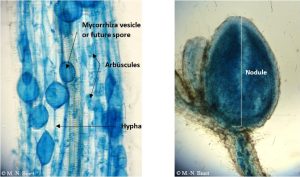Spatiotemporal phenotypic diversity of symbiotic populations of Trifolium saxatile: arbuscular mycorhizal fungi and nitrogen-fixing bacteria
The aim of the Trifolium saxatile project is to examine the spatial and temporal response of the plant and its symbiotic partners (mycorrhiza and rhizobia) facing global change. The study is based on the resurrection approach: seeds of 90’s and 2016 were collected in three sites and cultivated under common conditions (in common garden and lab). We measure several traits on these plants like germination date, aerial and underground biomass, mycorrhization rate…
The lab experiment was set up in november and we are now recording the data on leaves and roots traits and quantifying the abundance of mycorrhizae into the plants’ rhizosphere. The roots of each individual have been colored, bringing out the chitin of the fungus cells. Then, a microscope observation allows us to estimate a percentage of colonization for each Trifolium plant. The observed fungus are endomycorizae, more precisely arbuscular mycorrhizae, belonging to the family of Glomeromycetes. Different parts of the fungus can be detected: extra-cellular hyphae, storage vesicles, spores and intra-cellular arbuscules. Arbuscules are a place of exchanges between plants and fungus (particularly carbon from plant to fungi, and in the opposite way nitrogen, phosphorus and water).
Nodules, root formations sheltering rhizobia, the bacterial symbiotic partner, are visible to the naked eye and also well apparent under the microscope. A part of the study is dedicated to this interaction too.
In a second step we plan to identify rhizobia and mycorrhiza species.

The two root symbiotic partners of Trifolium saxatile: arbuscular mycorrhizae (left) and nodule sheltering rhizobia (right).